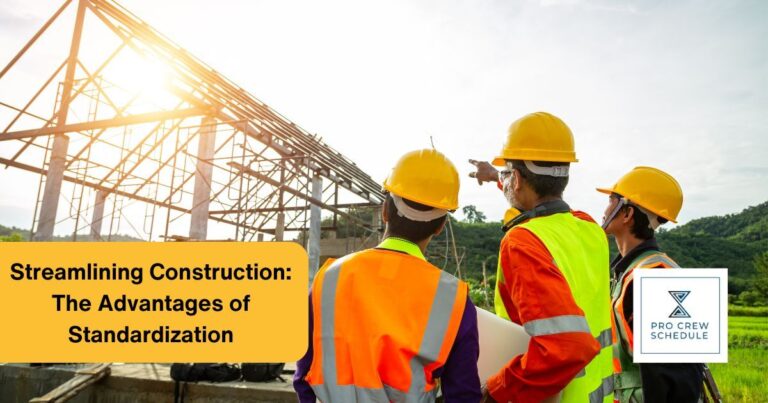Have you ever wondered why some construction projects breeze along while delays and missteps bog down others? It’s not just luck—often, it comes down to construction standardization. Imagine reinventing the template every time you build a house, figuring out the best materials, methods, and designs from scratch. It would be chaotic and costly.
Construction standardization is all about bringing order to this complex process. By setting consistent guidelines and using uniform practices, the construction industry can streamline operations, boost efficiency, and ensure higher quality. In this article, we’ll dive into what construction standardization means, why it’s a game-changer for the industry, and how it’s shaping the future of building. So, whether you’re a seasoned pro or just curious about how things get done, read on to discover how standardization makes construction smarter and smoother.
What is Construction Standardization?
Construction standardization is a game-changer in the building industry, aiming to bring order and consistency to what can often feel chaotic and unpredictable. Imagine if every restaurant you visited had a completely different menu, with varying ingredients and cooking styles. It would be confusing and frustrating. That’s kind of what it’s like in construction without standardization. The industry can be complex, and having a set of clear, uniform practices helps make everything run smoother.
At its heart, construction standardization sets common guidelines for materials, methods, and designs. Think of it as creating a recipe that everyone follows. If every project used the same type of concrete or adhered to the same construction methods, it would eliminate a lot of guesswork and variation. This uniformity simplifies procurement and ensures everything fits together as expected, making projects more reliable.
What are the Benefits of Construction Standardization?
Let’s discuss why construction standardization is important and how it can improve things. Imagine if every time you bought a new gadget, you had to figure out a different way to charge it or connect it to your devices. Now, apply that idea to construction, where standardization can make everything smoother and more predictable.
Efficiency
First off, efficiency is a huge win. With standardized materials and processes, projects can move along faster. Think of it like having a set of pre-measured ingredients ready to go for your favorite recipe. You don’t waste time figuring out what goes where or dealing with surprises. Everything fits together seamlessly, meaning fewer delays and a quicker path from blueprints to the finished building.
Consistency & Quality
Then there’s consistency and quality. When everyone follows the same guidelines, the result is much more reliable. It’s like knowing that every time you order your favorite dish from a restaurant, it will taste just right. In construction, this means fewer unexpected issues and a higher quality across the board.
Safety
Safety is another big plus. Standardized safety protocols mean everyone on site follows the same rules, which helps prevent accidents and keeps everyone safe. It’s like having a clear set of traffic rules—everyone knows what to do, which keeps things running smoothly.
Communication
Communication also benefits. It’s easier to stay on the same page when everyone uses the same forms and procedures. There’s less room for misunderstandings, which means fewer mix-ups and smoother project coordination.
Cost Savings
Finally, cost savings often come into play. Standardized materials and processes can reduce waste and reduce the need for custom solutions, which means savings that can be passed on to clients or invested in other aspects of the project. Plus, having a solid material schedule in construction helps keep everything on track and prevents overbuying or running out of supplies, making it easier to save even more.
In short, construction standardization brings order to the often chaotic building world. It speeds up projects, ensures consistent quality, keeps everyone safe, and makes communication a breeze. So next time you see a sleek, new building going up, remember that behind the scenes, standardization might just be making it all come together with impressive efficiency.
Steps Towards Construction Standardization
Standardizing construction processes might seem daunting, but it’s about making everything run more smoothly and efficiently. Here’s a straightforward way to think about it:
Pinpoint What Needs Standardizing
First, determine which parts of the construction process could use a uniform approach. It’s like deciding which areas of your project could benefit from more consistency. Some of the areas in construction management that can be standardized are the following:
- Design Specifications: Consider standardizing design elements as having a winning formula. By using consistent design specs, you simplify the design process and make it easier to replicate successful projects. This is especially handy for developments where similar designs are used repeatedly.
- Project Management: Streamlining project management practices—like scheduling, budgeting, and quality control—means fewer surprises and smoother operations. It’s like having a clear roadmap that guides the project from start to finish. Using tools such as construction crew scheduling software can further enhance this by optimizing labor allocation and ensuring everyone is on the same page.
- Inspection and Testing Procedures: Standardizing how you inspect and test materials and workmanship ensures that everything meets the required standards. It’s about maintaining high quality and catching any issues before they become problems.
- Documentation and Reporting: Have you ever felt lost in paperwork? Standardizing forms and reports makes it a breeze to keep track of inspections, changes, and progress. It ensures everyone involved stays on the same page and that nothing falls through the cracks.
- Materials: Imagine if you had to pick and test new materials every time you built something. Standardizing materials like concrete, steel, or insulation ensures consistent quality and performance every time. Plus, it makes buying and managing supplies a lot easier.
Create Clear Guidelines
Next up, develop detailed guidelines for these areas. This means setting specific rules for materials and methods so everyone knows exactly what’s expected. It’s about making things crystal clear, so there’s no guesswork involved. Some of the questions that should be asked are as follows:
- What guidelines should be followed to ensure compliance with local building codes?
- What are the standard procedures for scheduling, budgeting, and managing project timelines?
- What guidelines should be followed for recurring inspections and quality control?
- What standardized forms and templates should be used for inspections, change orders, and progress reports?
- What specific types and grades of materials should be used for various construction elements?
Get Everyone’s Input
Talk to the people who will be using these standards—contractors, architects, engineers, and suppliers. Their insights are crucial for ensuring the standards are practical and work in the real world. Additionally, feedback on how crew planning software can be integrated effectively can be gathered to ensure it complements the standards and supports efficient workforce management.
Construction workers can voice their concerns in several effective ways, ensuring their issues are heard and addressed promptly. Here are some key methods:
- Open-Door Policy: Establish an open-door policy so that workers feel comfortable contacting you with their concerns. Make it clear that your door is always open for feedback and issues.
- Scheduled Meetings: Hold regular meetings with workers or project teams where they can discuss any issues or suggestions. This could be weekly or bi-weekly, depending on the project’s scale and duration.
- Feedback Forms: Provide feedback forms or surveys where workers can anonymously submit their concerns or suggestions.
Train Your Team
Once the standards are set, it’s time to train everyone on how to follow them. Think of it as getting everyone up to speed so they know the ropes and can implement the new procedures effectively. Start using the latest standards on some projects. It’s like a trial run—see how things go and tweak as needed based on your learning.
Develop a Training Plan
Kick things off by creating a solid training plan. Think of it as your roadmap—it should cover everything your team needs to know about construction standardization. Lay out clear objectives, key topics, and a timeline so everyone knows what to expect and when.
Hands-On Training
Get your team rolling with hands-on training. Let them dive into real or simulated scenarios where they can apply the standards firsthand. It’s like getting practical experience with a new skill; it really helps cement what they’ve learned.
Create a Support System
Set up a support system where team members can easily ask questions or get help with the standards. Whether it’s having a go-to contact person or an online forum, ensure there’s a place for them to turn when they need extra guidance.
Utilize Technology
Bring Technology into your training to make things more engaging and practical. Use online platforms, e-learning modules, or virtual simulations for a flexible and interactive experience. And don’t forget to include training on construction scheduling software. This way, your team will get hands-on practice with tools that help manage timelines and keep projects on track, all while sticking to those essential standardized processes.
Keep an Eye on Things
Monitor how the standards work and gather feedback from those involved. This helps you catch any issues early and make improvements as needed. Utilizing construction crew management software, like Pro Crew Schedule, can also provide valuable insights into crew performance and productivity, making it easier to address any issues promptly.
Remember that construction methods and materials change over time. So, keep your standards up-to-date by revisiting and revising them regularly to stay current with industry trends.
In summary, standardizing construction processes involves creating clear, practical guidelines and ensuring everyone knows and follows them. This makes everything more efficient and helps ensure consistent, high-quality results.







